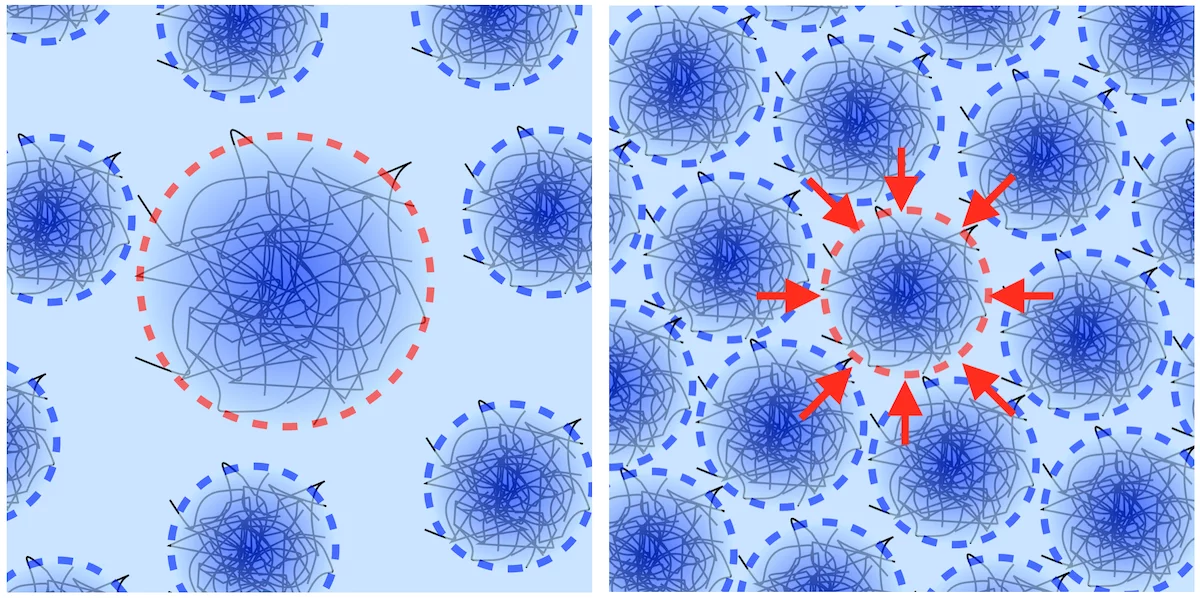Colloids – mesoscopic particles suspended in a solvent – are a class of soft materials that are common in our everyday lives and are used in many applications. They are also used as model systems for fundamental aspects of condensed matter physics. Colloids comprise hard, incompressible and soft, deformable particles. Hard spheres have been the subject of many studies, as a hard-sphere repulsion is present in many colloidal systems and is also relevant in atomic and molecular materials, and their phase behavior is quite well understood. Next to hard spheres, soft and deformable colloidal particles are of great interest, as their softness makes these particles responsive to changes in their environment and, therefore, these particles have potential for many applications, e.g. as sensor particles or for drug delivery. However, their fundamental behavior is not as well understood as that of hard spheres. This is due to the importance and the interplay of the particle-internal as well as the colloidal degrees of freedom. The reactiveness of soft colloids implies that their interaction and phase behavior can change with temperature, pH, polydispersity, or other control parameters of their environment. Up to date, a general model for the interaction and phase behavior of such responsive particles is lacking.
One of the most striking effects of such particle responsiveness is the spontaneous deswelling of colloidal pNIPAM microgels in concentrated suspensions – a good model system for soft colloids. Large pNIPAM microgels spontaneously deswell to the size of the smaller microgels in their surrounding. This implies a reduction of polydispersity, an effect that is not known from any other material. In our recent work, we have presented a model for this spontaneous deswelling behavior based on the osmotic pressure of the pNIPAM suspension, which is given by counterions originating from the pNIPAM microgels. We have also shown how the deswelling behavior changes the phase behavior of polydisperse suspensions, where the freezing point is linked to particle deswelling and the corresponding reduction of polydispersity.
Our model for deswelling at high concentrations establishes a link of particle softness and colloidal phase behavior that has as yet not been considered in the literature. But many aspects remain unanswered. The interaction and its dependence on suspension concentration is still not modeled in a way that would allow to predict the collective behavior in crystallization or in the glass transition observed in soft colloids. Various interactions are discussed in the literature to predict the phase behavior, but the agreement with experimental work is often poor. While several interaction models predict a rich crystalline phase behavior, only crystal phases also known from hard colloids are observed experimentally. In a study of the glass transition of microgels, we have shown that the softness of these particles changes the fragility as also observed in other glass formers. The mechanism for this variation of fragility is, however, not known.
New models for the behavior of soft colloids must link their internal structure with their interaction and phase behavior. We will achieve this by building on our model for spontaneous deswelling and by studying microgels with various softness to observe the transition from hard-sphere-like to soft behavior in their structure and dynamics. For this, we will use a combination of scattering techniques, rheology, and osmometry as well as direct imaging of microgel suspensions. The main goal is to find a model for soft microgels that can predict the single-particle as well as the suspension behavior and to obtain insight into the crystallization and glass transition of soft particles.
Publications
- A. Scotti, M. Pealeaz-Fernandez, U. Gasser, and A. Fernandez-Nieves, Phys. Rev. E 103, 012609 (2021), Osmotic pressure of suspensions comprised of charged microgels.
- U. Gasser, A. Scotti, and A. Fernandez-Nieves, Phys. Rev. E 99, 042602 (2019), Spontaneous deswelling of microgels controlled by counterion clouds.
- A. Scotti, U. Gasser, E.S. Herman, J. Han, A. Menzel, L.A. Lyon, and A. Fernandez-Nieves, Phys. Rev. E 96, 032609 (2017), Phase behavior of binary and polydisperse suspensions of compressible microgels controlled by selective particle deswelling.
- A. Scotti, U. Gasser, E.S. Herman, M. Pelaez-Fernandez, J. Han, A. Men- zel, L.A. Lyon, and A. Fernandez-Nieves, PNAS 113, 5576-5581 (2016), The role of ions in the self-healing behavior of soft particle suspensions.
- A. Scotti, W. Liu, J. S. Hyatt, E. S. Herman, H. S. Choi, J. W. Kim, L. A. Lyon, U. Gasser, A. Fernandez-Nieves, The Journal of Chemical Physics 142, 234905 (2015), The CONTIN algorithm and its application to determine the size distribution of microgel suspensions.
- U. Gasser, J.S. Hyatt, J.-J. Lietor-Santos, E.S. Herman, L.A. Lyon, A. Fernandez-Nieves, J. Chem. Phys. 141, 034901 (2014), Form factor of pNIPAM microgels in overpacked states.
- U. Gasser, J.-J. Lietor-Santos, A. Scotti, O. Bunk, A. Menzel, A. Fernandez- Nieves, Phys. Rev. E 88, 052308 (2013), Transient formation of bcc crys- tals in suspensions of poly(N-isopropylacrylamide)-based microgels.
- J.J. Lietor-Santos, B. Sierra-Martin, U. Gasser, and A. Fernandez-Nieves, Soft Matter 7, 6370-6374 (2011), The effect of hydrostatic pressure over the swelling of microgel particles.
- J.-J. Lietor-Santos, U. Gasser, R. Vavrin, Z.B. Hu, and A. Fernandez- Nieves, The Journal of Chemical Physics 133, 034901 (2010), Structural changes of poly(N-isopropylacrylamide)-based microgels induced by hydrostatic pressure and temperature studied by small angle neutron scattering.
- U. Gasser, A. Fernandez-Nieves, Phys. Rev. E 81, 052401 (2010), Crystal structure of highly concentrated, ionic microgel suspensions studied by small angle X-ray scattering.
- J.-J. Lietor-Santos, B. Sierra-Martin, R. Vavrin, Z. Hu, U. Gasser, and A. Fernandez-Nieves, Macromolecules 42, 6225-6230 (2009), Deswelling Microgel Particles Using Hydrostatic Pressure.
- U. Gasser, B. Sierra-Martin, and A. Fernandez-Nieves, Phys. Rev. E 79, 051403 (2009), Crystal structure of highly concentrated, ionic microgel suspensions studied by neutron scattering.
Collaboration
- Prof. Alberto Fernandez-Nieves, Department of Condensed Matter Physics, University of Barcelona, 08028 Barcelona, Spain and ICREA-Institucio Catalana de Recerca i Estudis Avancats, 08010 Barcelona, Spain.
Funding
- SNF project 200020_184839
Associated junior researchers
- Boyang Zhou, PhD student
